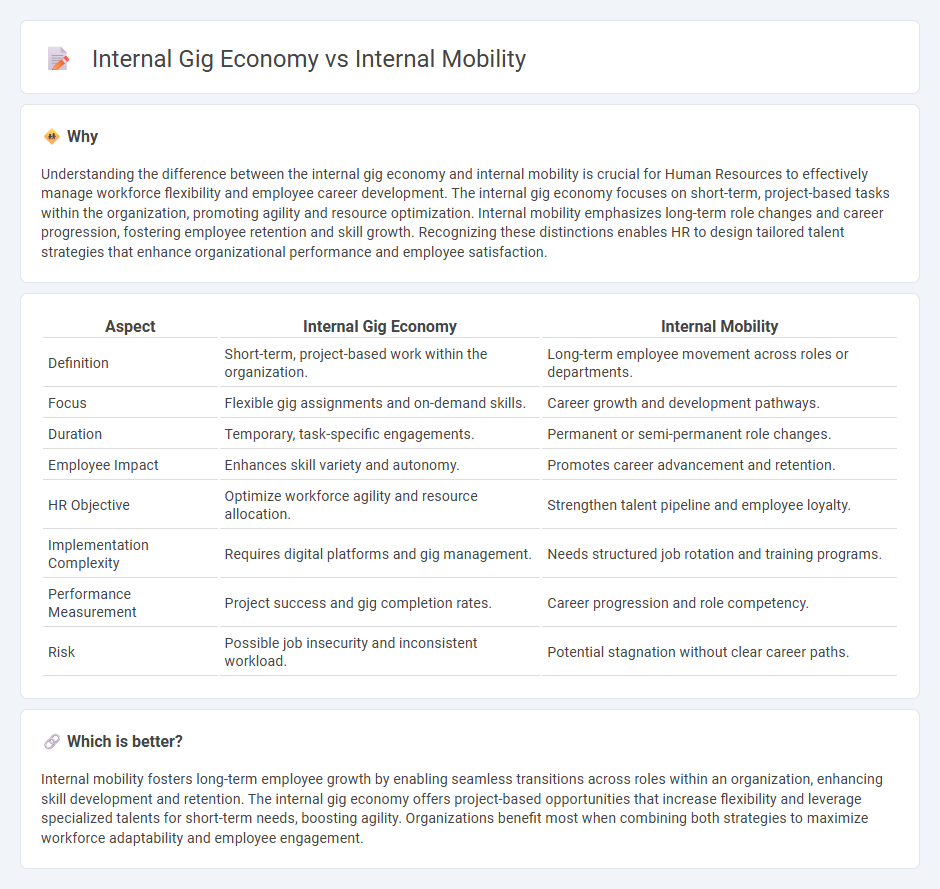
The internal gig economy enables employees to take on short-term, project-based roles within their organization, maximizing flexibility and skill utilization. Internal mobility focuses on longer-term career progression through promotions or lateral moves, fostering employee development and retention. Explore how these strategies can transform workforce engagement and agility.
Why it is important
Understanding the difference between the internal gig economy and internal mobility is crucial for Human Resources to effectively manage workforce flexibility and employee career development. The internal gig economy focuses on short-term, project-based tasks within the organization, promoting agility and resource optimization. Internal mobility emphasizes long-term role changes and career progression, fostering employee retention and skill growth. Recognizing these distinctions enables HR to design tailored talent strategies that enhance organizational performance and employee satisfaction.
Comparison Table
| Aspect | Internal Gig Economy | Internal Mobility |
|---|---|---|
| Definition | Short-term, project-based work within the organization. | Long-term employee movement across roles or departments. |
| Focus | Flexible gig assignments and on-demand skills. | Career growth and development pathways. |
| Duration | Temporary, task-specific engagements. | Permanent or semi-permanent role changes. |
| Employee Impact | Enhances skill variety and autonomy. | Promotes career advancement and retention. |
| HR Objective | Optimize workforce agility and resource allocation. | Strengthen talent pipeline and employee loyalty. |
| Implementation Complexity | Requires digital platforms and gig management. | Needs structured job rotation and training programs. |
| Performance Measurement | Project success and gig completion rates. | Career progression and role competency. |
| Risk | Possible job insecurity and inconsistent workload. | Potential stagnation without clear career paths. |
Which is better?
Internal mobility fosters long-term employee growth by enabling seamless transitions across roles within an organization, enhancing skill development and retention. The internal gig economy offers project-based opportunities that increase flexibility and leverage specialized talents for short-term needs, boosting agility. Organizations benefit most when combining both strategies to maximize workforce adaptability and employee engagement.
Connection
Internal gig economy and internal mobility are interconnected through their emphasis on flexible workforce deployment within organizations, enabling employees to take on diverse project-based roles without changing departments permanently. This approach enhances talent utilization by promoting skill development and career progression opportunities while meeting dynamic business needs efficiently. Leveraging internal gig platforms supports agile workforce strategies, which drive employee engagement and retention through increased job variety and personalized career pathways.
Key Terms
Career Pathing
Internal mobility enhances career pathing by enabling employees to transition between roles within an organization, fostering long-term growth and skill development. The internal gig economy offers project-based opportunities that provide diverse experiences but may lack clear progression paths. Explore how blending these models can optimize career development strategies.
Project-Based Assignments
Internal mobility emphasizes long-term career advancement within an organization, often involving promotions or lateral moves, while the internal gig economy revolves around short-term, project-based assignments that provide flexibility and skill diversification. Project-based assignments act as a crucial component of the internal gig economy by enabling employees to contribute to specific projects across departments without permanent role changes. Explore how leveraging project-based assignments can optimize talent utilization and foster agile workforce development within your company.
Talent Marketplace
Internal mobility emphasizes promoting employees through structured career pathways within an organization, while the internal gig economy leverages a talent marketplace to match skills with short-term project opportunities. Talent marketplaces optimize workforce agility by enabling employees to access diverse gigs, enhancing skill development and job satisfaction. Discover how integrating internal gig economies can transform your talent strategy.
Source and External Links
Internal Mobility: What Is It and Why Do You Need It? - This article discusses the concept of internal mobility and strategies to implement it, focusing on role-to-role mobility and supporting employee development.
Internal Mobility: An HR Professional's Guide - This guide provides an overview of internal mobility, its benefits, and how HR professionals can facilitate it within their organizations.
Internal Mobility: Your 2025 Guide - This article outlines practices for optimizing internal mobility, including securing leadership support and cross-training employees.
 dowidth.com
dowidth.com